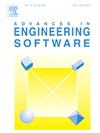一种用于螺栓连接设计与分析的线性化多向有限元模型
IF 5.7
2区 工程技术
Q2 COMPUTER SCIENCE, INTERDISCIPLINARY APPLICATIONS
引用次数: 0
摘要
螺栓连接是结构和机械系统中最常用的连接类型之一。传统上,螺栓连接是使用一定的标准和假设来设计的,以获得初始设计。然后使用解析或数值方法分析这些初始设计,以确保安全条件。每种方法都有其优点和缺点。本文介绍了一种基于多向有限元(FE)的螺栓连接模型,该模型对螺栓连接设计中使用线性静力分析的验证步骤特别有用。该模型结合了解析方法和数值方法的优点,在多个方向上部分地捕捉螺栓连接的行为,并以可接受的精度实现了节省时间,易于使用的解决方案。由于该模型的线性化特性,其应用也可扩展到一般螺栓连接结构的模态分析。使用其他作者先前的发现、模态测试和完整的3D模型分析验证了所提出的模型。对该模型的应用进行了论证,并明确指出了该方法的优缺点。本文章由计算机程序翻译,如有差异,请以英文原文为准。
A linearized multi-directional FE model for bolted connection design and analysis
The bolted joint is one of the most common connection types used in structures and mechanical systems. Traditionally, bolted connections are designed using certain standards and assumptions to obtain initial designs. These initial designs are then analyzed using analytical or numerical methods to ensure safety conditions. Each of these methods has its advantages and disadvantages. The study presented in this paper introduces a multi-directional finite element (FE) based bolted joint model, which is particularly useful for the verification step using linear static analysis in bolted connection design. This model combines the advantages of both analytical and numerical methods to partially capture the bolted joint behavior in multiple directions and achieve a time-saving, easy-to-use solution with acceptable accuracy. Due to the linearized characteristics, the application of the model can also be expanded to modal analysis for general bolted connection structures. The proposed model was verified using previous findings from other authors, modal testing, and full 3D model analysis. The applications of the model were demonstrated as well as the pros and cons of the proposed approach were pointed out clearly.
求助全文
通过发布文献求助,成功后即可免费获取论文全文。
去求助
来源期刊

Advances in Engineering Software
工程技术-计算机:跨学科应用
CiteScore
7.70
自引率
4.20%
发文量
169
审稿时长
37 days
期刊介绍:
The objective of this journal is to communicate recent and projected advances in computer-based engineering techniques. The fields covered include mechanical, aerospace, civil and environmental engineering, with an emphasis on research and development leading to practical problem-solving.
The scope of the journal includes:
• Innovative computational strategies and numerical algorithms for large-scale engineering problems
• Analysis and simulation techniques and systems
• Model and mesh generation
• Control of the accuracy, stability and efficiency of computational process
• Exploitation of new computing environments (eg distributed hetergeneous and collaborative computing)
• Advanced visualization techniques, virtual environments and prototyping
• Applications of AI, knowledge-based systems, computational intelligence, including fuzzy logic, neural networks and evolutionary computations
• Application of object-oriented technology to engineering problems
• Intelligent human computer interfaces
• Design automation, multidisciplinary design and optimization
• CAD, CAE and integrated process and product development systems
• Quality and reliability.
 求助内容:
求助内容: 应助结果提醒方式:
应助结果提醒方式:


